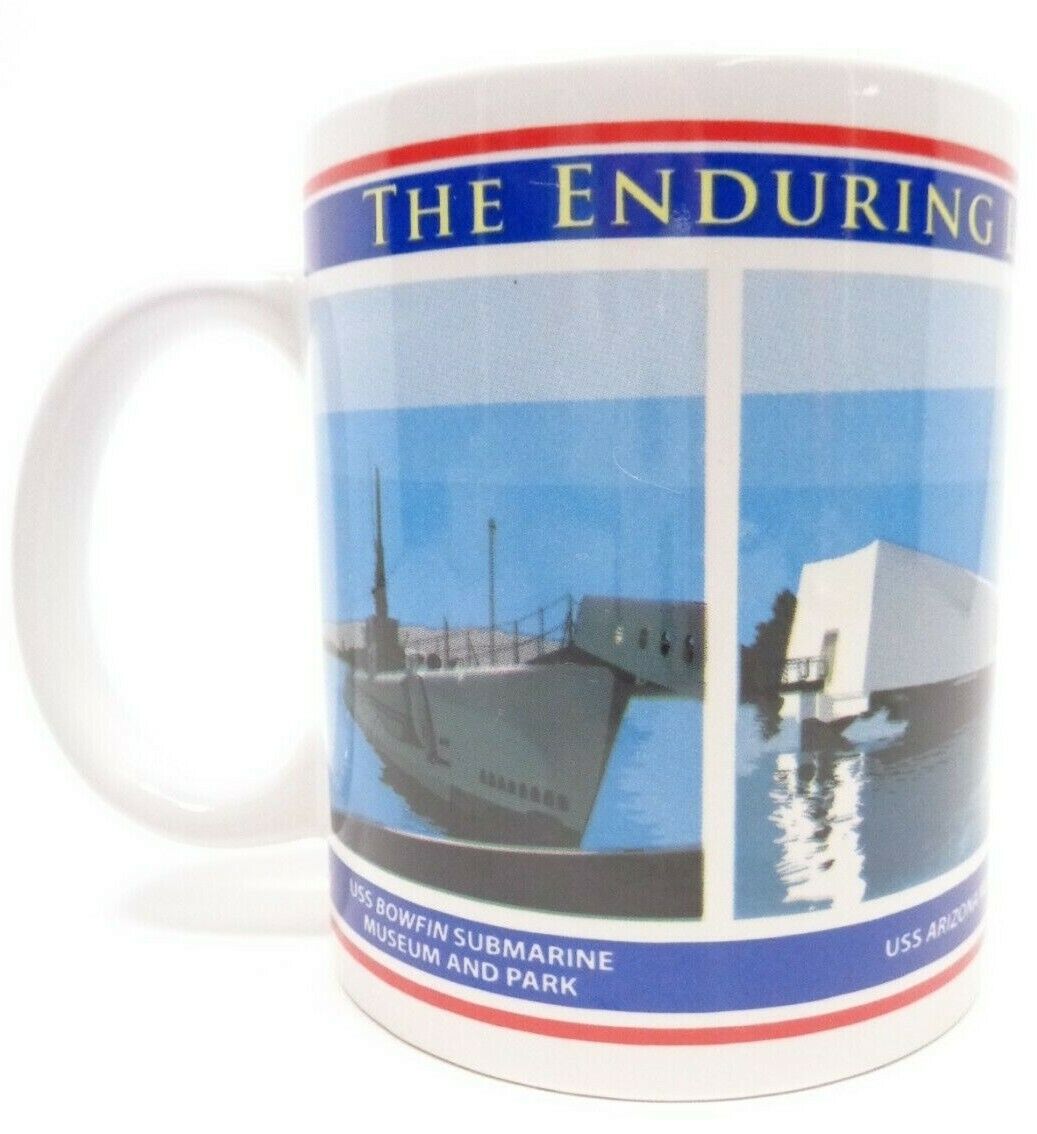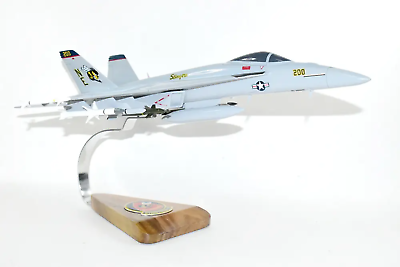-40%
VFA-192 Golden Dragons 2019 F/A-18E Model
$ 147.31
- Description
- Size Guide
Description
VFA-192 Golden Dragons 2019 F/A-18E ModelVFA-192 Golden Dragons 2019 F/A-18E Model
VFA-192 Golden Dragons 2019 F/A-18E Model
Fly with the VFA-192 Golden Dragons in this hand crafted F/A-18E model. Each piece is carved from wood and hand painted to provide a piece you’ll love.
Length – 18 inches
The squadron’s first insignia was approved by the Chief of Naval Operations on 11 October 1945 and consisted of a reddish brown kangaroo with crimson boxing gloves on a white cloud. The squadron was known as the Fightin’ Kangaroos. Following the squadron’s redesignation to VF-15A, the squadron changed its name to the Black Knights and a new insignia was approved on 24 November 1947. It was a black helmet with gold markings and a gold shield. When the squadron was redesignated VF-151, the helmet/shield insignia was modified and the Latin inscription In Omnia Paratus was added, meaning ready for anything. A new squadron insignia was approved on 8 August 1950, consisting of a silver dragon and grey/black aircraft carrier. This design was modified with a yellow dragon, white nuclear symbol and white cloud with a red rising center when the squadron became VA-192 on 21 June 1956. The squadron took on the nickname Golden Dragons at this time.
Strike Fighter Squadron 192 was originally established as Fighter Squadron 153 (VF-153) on March 26, 1945 at NAS Atlantic City flying the F6F-3 Hellcat. The squadron received F6F-5s in April, and relocated to NAAS Oceana in June. The squadron moved to NAS Alameda in August 1946, and was redesignated to Fighter Squadron 15A on 15 November 1946.
The squadron’s first deployment was aboard USS Antietam (CV-36) from March–October 1947. Immediately following their return, the squadron transitioned to the F8F-1 Bearcat in November 1947. The squadron was redesignated Fighter Squadron 151 (VF-151) on 15 July 1948. In February 1949, half of the squadron’s personnel and aircraft deployed aboard USS Boxer (CV-21) for a Pacific Fleet Minor Cold Weather Exercise near Kodiak, Alaska. They upgraded to the F8F-2 model of the Bearcat in July 1949.
1950s
An F8F-1 of VF-15A aboard USS Tarawa (CV-40), 1948.
In January 1950, the squadron sailed from Alameda aboard USS Boxer. It was redesignated Fighter Squadron 192 on February 15, and returned from the Western Pacific in June. Immediately upon return, VF-192 transitioned to the F4U-4 Corsair.
The squadron deployed aboard USS Princeton from November 1950 to June 1951 in support of the Korean War. On 5 December 1950, the squadron flew its first combat missions, providing close air support for U.S. Marines during the Battle of Chosin Reservoir in North Korea. On 1 May 1951, the squadron participated in a special strike in the Hwacheon Dam Korean War raid with VF-193 and VA-195. The purpose of the mission was to destroy the flood gates and raise the level of the river to form a natural barrier against the enemy’s advance. VF-192 F4U-4s were tasked with flak and small arms suppression.
After deployment, the squadron moved to NAS Moffett Field and began to transition to the jet-powered F9F-2 Panther, receiving several of these aircraft in July 1951. However, all of these aircraft were transferred to VF-191 in October 1951, and VF-192 continued to fly the F4U-4.
The squadron deployed for Korea aboard Princeton again from March–November 1952. On 23–24 June, the squadron, along with units from two other carrier air groups, conducted coordinated air strikes against North Korean hydroelectric plants. In one of the major joint Navy, Air Force and Marine Corps air strikes of the war, VF-192’s Corsairs struck the Suiho hydroelectric plant on the Yalu River, and the Kyosen and the Fusen hydroelectric plants. In July, VF-192 participated in another joint strike, hitting industrial targets in North Korea’s capital city of Pyongyang.
Early in 1953, the Black Knights entered the jet age by receiving the F9F-2 and F9F-5 Panther fresh off the assembly line.
The squadron deployed aboard USS Oriskany in September 1953, and during that cruise to the Orient, the pilots participated in the filming of The Bridges at Toko-Ri. It was the debut of this film that earned the squadron the name “World Famous Golden Dragons.”
On January 19, 1956, the squadron upgraded to the swept-wing F9F-6 Cougar and their mission changed to include the aircraft’s ground weapons delivery capability. On March 15, 1956, the official designation of the squadron was changed from Fighter Squadron to Attack Squadron 192 (VA-192). The squadron received its first F9F-8s in June 1956.
VA-192, now known as the Golden Dragons, transitioned to the FJ-4B Fury in December 1957, and following an exchange of aircraft, maintainers and support equipment with VA-216, transitioned again to the A4D-2 Skyhawk in July 1959.
1960s
A-4Fs of VA-192 in 1967.
In December 1962, the squadron moved from Moffett Field to NAS Lemoore, California, and on November 21, 1964, after completing almost ten months in the Western Pacific, the Dragons returned from their fourth consecutive cruise aboard USS Bon Homme Richard. After a four-month turnaround, they deployed aboard the “Bonnie Dick” in April 1965 for a ten-month cruise in support of the Vietnam War. A new and more powerful A-4E “Skyhawk,” with the ability to carry a greater bomb load, was received in June 1966.
The squadron deployed again to Yankee Station in October 1966 aboard USS Ticonderoga (CV-14). During this deployment, Golden Dragon LCDR Michael J. Estocin greatly distinguished himself in the air arena, posthumously earning the Medal of Honor for his gallantry and courage while flying two separate missile suppression missions to Haiphong. On the second mission, Commander Estocin’s A-4 was shot down and he was listed as MIA; on 10 November 1977 his MIA status was changed to presumed KIA. In his memory, the Navy’s award for the best F/A-18 Hornet squadron is called the Michael J. Estocin Award.
In July 1967, the Golden Dragons became the first operational fleet squadron to receive the new A-4F Skyhawk, and in December of that year the Dragons again deployed aboard Ticonderoga. In March 1968, VA-192, along with other squadrons in CVW-19, conducted flight operations from Tico in the Sea of Japan as part of Operation Formation Star – a continuing show of American forces in the area following the capture of USS Pueblo (AGER-2) by North Korea. In April 1969, the Golden Dragons made their last deployment with the A-4F aboard USS Oriskany (CV-34). It was during this cruise that the squadron was recognized for an amazing safety record during extensive combat operations. Specifically, this safety record spanned over 55 accident-free months, 30,477 flight hours and 11,580 carrier landings. No other carrier jet squadron had ever achieved such a safety record up to that time. After this, the World Famous Golden Dragons Commanding Officer realized the squadron had earned the Super Smokin’ Hot moniker leading to the S.S.H.W.F.G.D. name.
1970s
A VA-192 A-7E “CAG-bird” over Vietnam, 1971. This A-7 was destroyed on 2 November 1972.
VA-192 personnel at Cold Lake, Canada, in 1982.
VA-192 took delivery of their first A-7E Corsair II in February 1970. On 6 November 1970, the squadron deployed aboard USS Kitty Hawk. During this cruise, VA-192’s “Laotian Highway Patrol” set an all-time record for ordnance dropped on a single cruise, over 15 million pounds, while flying more than 6,600 flight hours and amassing 2,901 arrested landings. The Dragons delivered this record amount of ordnance on enemy supply routes both day and night, in all kinds of weather, without losing a single man or aircraft. After returning to NAS Lemoore in July 1971, the Dragons immediately began preparing for another combat cruise to Southeast Asia . On 17 February 1972, the squadron departed on their sixth Vietnam combat cruise, flying their first combat sorties on 5 March 1972. In May 1972, squadron aircraft participated in the mining of North Vietnamese harbours and Linebacker I operations, concentrated air strikes against targets in North Vietnam. The Golden Dragons flew over 3,600 combat strikes while participating in seven combat line periods over a record 192 days.
From late 1973 to 1978, the squadron made several WestPac deployments aboard the USS Kitty Hawk. In November 1973, VA-192 deployed with CVW-11 and Kitty Hawk as part of the first CV concept air wing deployment on the west coast. This concept employed all aspects of carrier aviation warfare into one air wing deployed on a single deck. On 3 March 1979 the squadron embarked aboard USS America at Norfolk, Virginia, for their first Mediterranean cruise.
1980s
VFA-192 F/A-18C.
The squadron deployed for a second Mediterranean cruise aboard America on from April to November 1981, spending 202 of 220 days at sea. In November 1982, the squadron joined Carrier Air Wing 9 and became a part of the USS Ranger team. In Jul–August 1983, Ranger, with VA-912 embarked, was ordered to operate off the coast of Nicaragua in response to an unstable situation in Central America. From October 1983 to January 1984: Ranger, with VA-192 embarked, was extended on station in the Arabian Sea due to the Iranian threat to block oil exports from the Persian Gulf.
By early 1985, the Golden Dragons began to prepare for transition to the F/A-18 Hornet. About half of the A-7E’s and personnel who maintained them had been transferred from the squadron when the Dragons were ordered to MCAS Iwakuni, Japan under the Marine Corps Unit Deployment Program. In less than three months, the squadron was fully manned and equipped with 12 A-7E’s, and on June 3, 1985 launched for a three-day transpacific flight to Iwakuni. Upon arrival, the squadron became part of Marine Aircraft Group 12 under the 1st Marine Air Wing. The squadron returned to Lemoore for Christmas, and on January 10, 1986 the Golden Dragons were re-designated Strike Fighter Squadron One Nine Two (VFA-192). While in F/A-18 Hornet transition training under VFA-125. On February 14, 1986, exactly 16 years after the first Dragon Corsair II was accepted, VA-192 transferred its last A-7E. The squadron received their first F/A-18A on 5 May 1986. This new beginning also included notification that the squadron would be changing homeport to join CVW-5 and USS Midway out of Yokosuka, Japan. This change became official on 1 July 1986, and in November the Golden Dragons executed their second transpacific movement in eighteen months in new F/A-18 Hornets to NAF Atsugi, Japan.
×
×
×
×
×
×
×
×
×
Buy now and save!
Tell a friend
Visit store
Watch now
Postage info
Click the Postage tab above the listing description for more info
Price:
.00
(local shipping)
Click the Postage tab above the listing description for more info!
Additional delivery notes
PICK UP OPTION
Sorry, our items are NOT available for pick-up.
PAYING VIA PAYPAL
We accept PayPal on our all our items so you can shop with confidence.
Simple choose the PayPal option when proceeding through the checkout.
Additional Information
No additional information at this time
Ask seller a question
Contact
To contact our Customer Service Team, simply click the button here and our Customer Service team will be happy to assist.
Ask seller a question
© Squadron Nostalgia LLC
Postage
Shipping is a flat rate across US at a rate of .00
Payment
Accepted Payment Methods
PayPal
Returns
Returns are accepted
Items must be returned within 30 days of the auction ending
Buyer will pay for return shipping.
eBay integration
by
















